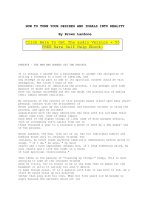nonprofit meetings minutes and records, how to run your nonprofit corporation so you don't run into trouble (2008)
Bạn đang xem bản rút gọn của tài liệu. Xem và tải ngay bản đầy đủ của tài liệu tại đây (3.05 MB, 244 trang )
Dear friends,
Since 1971, Nolo has worked hard to help Americans get
a fair shake from the legal system. How? By producing
books, software, forms and a website that translate
legal jargon into plain English, off er clear instructions
for routine tasks and break down complex systems into
easy-to-understand components.
All of our publications are relentlessly researched and
tested by a dedicated group of in-house legal editors.
And when we come out with a new edition, you’ll know
that it’s been thoroughly updated.
ere’s a reason why Nolo is not only the nation’s oldest,
but also the most respected provider of legal information.
Our mission, refl ected in everything we publish, is to give
consumers and small businesses the best information
available. We’re proud that tens of millions of Americans
have looked to Nolo to help them solve their problems
and achieve their goals.
Ralph Warner,
Nolo co-founder
e
N O L O
Story
Whether you have a simple question or a complex
problem, turn to us at:
ALWAYS UP TO DATE
Sign up for
NOLO’S
LEGAL UPDATER
Old law is bad law. We’ll
email you when we publish
an updated edition of this
book—sign up for this
free service
at nolo.com/
legalupdater.
Find the latest updates
at
NOLO.COM
Recognizing that the law
can change even before you
use this book, we post legal
updates during the life of this
edition at nolo.com/updates
.
Is this edition the newest?
ASK US!
To make sure that this is the
most recent available, just
give us a call at 800-728-3555.
(Please note that we
cannot off er legal advice.)
NOLO.COM
Your all-in-one legal resource
Need quick information about wills, patents,
adoptions, starting a business—or anything else
that’s aff ected by the law? Nol
o.com is packed
with free articles, legal updates, resources and a
complete catalog of our books and software.
NOLO NOW
Make your legal documents online
Creating a legal document has never been easier
or more cost-eff ective! Featuring Nolo’s Online
Will, as well as online forms for LLC formation,
incorporation, divorce, name change—and many
more! Check it out at o.c
om
.
NOLO’S LAWYER DIRECTORY
Meet your new attorney
If you want advice from a qualifi ed attorney, turn
to Nolo’s Lawyer Directory—the only directory
that lets you see hundreds of in-depth attorney
profi les so you can pick the one that’s right for
you. Find it at .
OUR MISSION
Make the law as simple as
possible, saving you time,
money and headaches.
N O L O
Your Legal Companion
“In Nolo you can trust.” —THE NEW YORK TIMES
We believe accurate, plain-English legal information should help
you solve many of your own legal problems. But this text is not a
substitute for personalized advice from a knowledgeable lawyer.
If you want the help of a trained professional—and we’ll always
point out situations in which we think that’s a good idea—
consult an attorney licensed to practice in your state.
Please note
1st edition
Nonprofit
Meetings, Minutes
& Records
How to Run Your Nonprofit Corporation
So You Don’t Run Into Trouble
By Attorney Anthony Mancuso
FIRST EDITION AUGUST 2008
Editor DIANA FITZPATRICK
Cover Design SUSAN PUTNEY
CD-ROM Preparation ELLEN BITTER
Proofreading ROBERT WELLS
Index SONGBIRD INDEXING
Printing CONSOLIDATED PRINTERS, INC.
Mancuso, Anthony.
Nonprofit meetings, minutes & records : how to run your nonprofit corporation so
you don’t run into trouble / by Anthony Mancusco. 1st ed.
p. cm.
ISBN-13: 978-1-4133-0892-1 (pbk.)
ISBN-10: 1-4133-0892-9 (pbk.)
1. Nonprofit organizations Management. 2. Nonprofit organizations Law and
legislation. I. Title. II. Title: Nonprofit meetings, minutes and records.
HD62.6.M367 2008
658.4'56 dc22
2008012905
Copyright © 2008 by Anthony Mancuso.
ALL RIGHTS RESERVED. PRINTED IN THE U.S.A.
No part of this publication may be reproduced, stored in a retrieval system, or transmitted in any
form or by any means, electronic, mechanical, photocopying, recording, or otherwise, without prior
written permission. Reproduction prohibitions do not apply to the forms contained in this product
when reproduced for personal use.
Quantity sales: For information on bulk purchases or corporate premium sales, please contact the
Special Sales Department. For academic sales or textbook adoptions, ask for Academic Sales. Call
800-955-4775 or write to Nolo, 950 Parker Street, Berkeley, CA 94710.
Acknowledgments
The author thanks Diana Fitzpatrick for editing this first
edition. A big thanks to the entire Nolo team for helping me
put together and publish another consumer law book for
hardworking nonprofits.
About the Author
Anthony Mancuso is a corporations and limited liability
company expert. He graduated from Hastings College of the
Law in San Francisco, is a member of the California State Bar,
writes books and software in the fields of corporate and LLC
law, and studies advanced business taxation at Golden Gate
University in San Francisco. He has also been a consultant for
Silicon Valley EDA (Electronic Design Automation) companies,
recently working on a C++ open-source integrated circuit
database project team. He is the author of several Nolo
books on forming and operating corporations (both profit
and nonprofit) and limited liability companies. His titles
include Incorporate Your Business, How to Form a Nonprofit
Corporation (national and California editions), The Corporate
Records Handbook, Form Your Own Limited Liability Company,
Your Limited Liability Company: An Operating Manual, and LLC
or Corporation? He wrote and programmed Nolo’s LLC Maker
software program, which generates state-by-state articles and
other forms for organizing LLCs. His books and software have
shown over a quarter of a million businesses and organizations
how to form a corporation or LLC. He also is a licensed
helicopter pilot and has performed for years as a guitarist in
various musical idioms.
CHAPter
Table of Contents
Your Nonprofit Meeting Companion
1
Housekeeping 101—Understand
and Organize Your Records
Your Key Organizational Documents 5
Organize Your Corporate Records 14
Looking Up the Law Yourself 15
State Corporate Filing Offices 18
When to Consult a Professional 18
2
Obtaining Board or Member Approval—
Meetings and Written Consents
When Is Board Approval Required? 22
When Is Membership Approval (or Ratification) Required? 23
How Boards (and Members) Take Action 24
Why You Need to Document Key Corporate Decisions 29
3
Premeeting Steps—How to Call, Notice,
and Prepare for Your Meeting
Premeeting Steps—An Overview 32
Going rough the Steps 34
4
e Big Day—Holding Your Meeting
Decide What Rules You’ll Follow 70
Gather at Your Meeting Location 70
Appoint a Chairperson and Secretary 71
Call the Meeting to Order 72
Make Sure at a Quorum Is Present 72
Get Down to Business 76
Approving Resolutions 80
Voting Rules for Directors and Members 83
e End: Adjourn the Meeting 88
5
Minutes for Directors’ Annual and Special Meetings
Some Basics on Minute-Taking 90
Preparing Minutes for an Annual Meeting of Directors 92
Preparing Minutes for a Special Meeting of Directors 101
6
Minutes for Members’ Annual and Special Meetings
Some Basics on Minute-Taking 112
Preparing Minutes for an Annual Meeting of Members 113
Preparing Minutes for a Special Meeting of Members 124
7
How to Take Action by Written Consent
Check Your Written Consent Rules 137
Prepare the Written Consent Form 138
Place Signed Consent Forms in Your Corporate Records Book 141
8
Help Beyond is Book
How to Find the Right Lawyer 144
How to Find the Right Tax Adviser 150
Appendixes
A
How to Use the CD-ROM
Installing the Form Files Onto Your Computer 152
Using the Word Processing Files to Create Documents 153
Forms on the CD-ROM 156
B
Nonprofit Corporate Contact Information
Alabama 159
Alaska 159
Arizona 159
Arkansas 160
California 160
Colorado 161
Connecticut 161
Delaware 161
District of Columbia 162
Florida 162
Georgia 163
Hawaii 163
Idaho 163
Illinois 164
Indiana 164
Iowa 165
Kansas 165
Kentucky 165
Louisiana 166
Maine 166
Maryland 167
Massachusetts 167
Michigan 168
Minnesota 168
Mississippi 168
Missouri 169
Montana 169
Nebraska 170
Nevada 170
New Hampshire 170
New Jersey 171
New Mexico 171
New York 172
North Carolina 172
North Dakota 173
Ohio 173
Oklahoma 173
Oregon 174
Pennsylvania 174
Rhode Island 175
South Carolina 175
South Dakota 175
Tennessee 176
Texas 176
Utah 177
Vermont 177
Virginia 177
Washington 178
West Virginia 178
Wisconsin 179
Wyoming 179
C
Meeting and Minutes Forms
Call, Notice, and Meeting Preparation Forms
Membership Roster 182
Meeting Summary Sheet 183
Call of Meeting 184
Meeting Participant List 185
Notice of Meeting 186
Waiver of Notice of Meeting 187
Acknowledgment of Receipt of Notice of Meeting 188
Proxy 189
Approval of Minutes 190
Minutes and Consent Forms
Minutes of the Annual Meeting of Directors 191
Minutes of Special Meeting of Directors 195
Minutes of Annual Meeting of Members 198
Minutes of Special Meeting of Members 202
Written Consent to Action Without Meeting 205
Index
Your Nonprofit Meeting Companion
F
orming a nonprofit corporation is an intensive, and often
exhausting, task. All too often, after the founders successfully
create their new entity and obtain tax-exempt status, they
take a deep breath and get back to doing what they do best—
helping a cause or carrying out a mission. However, when you
form a nonprofit corporation, you take on certain responsibilities.
Although you probably don’t feel like part of a corporation, you
must learn how to take action as a corporation and keep proper
records. You will need to properly call, notice, hold, and document
director, committee, and membership meetings and create a
corporate records book to store your minutes and other corporate
records.
These are not difficult tasks, but you don’t want to neglect them.
Failure to take care of your corporate responsibilities could result
in your nonprofit being stripped of its corporate and tax-exempt
status. This could have disastrous consequences, including the
loss of crucial tax benefits for your nonprofit and limited liability
protection for your principals. It could also mean that your founders
and principals are held personally liable for taxes, penalties, and
interest charges assessed by the IRS and state.
This book explains everything you need to know to take care
of your basic corporate responsibilities. We show you step by step
how to:
call, notice, hold, and document meetings of directors, •
members, and committees
take action by written consent (for directors or members) •
without a meeting, and
set up a corporate records book.•
We also explain which type of corporate decisions or actions
require approval from your directors or members.
2
|
NONPROFIT MEETINGS, MINUTES & RECORDS
The paperwork you need to take corporate action consists of
notice and minutes forms for meetings or written consent forms. All
the forms you need are on the CD-ROM, so you can quickly and
easily make your own customized forms. There are samples of all
the forms in the text with detailed instructions on how to fill them
out. We also include hard copies of the forms in Appendix C for
easy reference.
With this book and its sample forms, you will find that you are
able to take care of most of the routine regular and special meeting
paperwork for your nonprofit yourself. You may need to consult a
lawyer or accountant if you have a complicated legal or tax issue—
we explain how to find a helpful nonprofit lawyer and tax adviser
in Chapter 8.
The information and forms in this book are intended primarily
for nonprofits that are exempt from federal income taxation under
Section 501(c)(3) of the Internal Revenue Code. Generally, these
are nonprofits that are organized and operated for charitable,
religious, education, literary, or scientific purposes. This can
include a wide range of nonprofits—from small grassroots
organizations to medium-sized and larger institutional nonprofits.
Other types of nonprofits (such as 501(c)(4) political lobbying
nonprofits, 501(c)(6) social welfare groups, and other mutual
benefit corporations—homeowners’ associations, social clubs, and
the like) may also find this book useful to learn how to hold and
document regular and special meetings of directors, committees,
and members.
Congratulations! With the help of this book, you can rest
assured that you’re taking care of your basic corporate house-
keeping responsibilities. Soon, you can get back to other important
tasks—whether it’s saving the sea turtles, running a museum or
hospital, or forming a kid’s sports group.
l
Your Key Organizational Documents 5
Your Primary Corporate Document—Articles of Incorporation 5
Your Operating Manual—Bylaws 7
Your First Meeting—Organizational Meeting Minutes 10
Membership Roster 11
Ongoing Records—Minutes and Written Consents 13
Other Records 13
Organize Your Corporate Records 14
Looking Up the Law Yourself 15
Locating Your State’s Nonprofit Laws 15
Finding Answers to Your Questions 16
Checking Other Laws 17
State Corporate Filing Offices 18
When to Consult a Professional 18
CHAPter
1
Housekeeping 101—Understand
and Organize Your Records
L
et’s start by getting acquainted with certain key corporate
documents; ones that you’ll refer to time and again through-
out the life of your nonprofit. These include your articles of
incorporation, bylaws, and other organizational documents. They
contain your mission statement, the procedures you must follow to
operate your nonprofit corporation, and rules to help you maintain
your tax-exempt status.
To operate effectively, you’ll need to keep your key corporate
documents well organized and easily accessible. We’ll show you
how to set up a corporate records book to help achieve this.
Keeping good records is not merely a formality: It can provide
crucial documentation in the event of an audit by the Internal
Revenue Service (IRS), a lawsuit, or even a disagreement among
directors, members, or anyone else about actions taken by your
nonprofit.
Why Incorporate a Nonprofit?
Many nonprofits start out as small grassroots organizations, spurred
on by the volunteer and part-time energy of just a few people working
out of someone’s house or office. Under state law, this type of loosely
structured arrangement is considered a nonprofit association. It has
the advantage of requiring minimal paperwork and it can obtain
tax-exempt status using the standard IRS Form 1023 that nonprofit
corporations use. However, every member of the nonprofit is personally
liable for the claims, debts, and taxes of the organization. So, as a
group increases in size and the scope of its work, it often decides to
incorporate to protect its founders and members from personal liability
for the group’s activities. ere are other advantages to incorporating
but this is often the main reason groups choose to do it.
4
|
NONPROFIT MEETINGS, MINUTES & RECORDS
Your Key Organizational Documents
Getting familiar with your corporate documents is a bit like reading
the directions for a new appliance—tedious but essential. For a
nonprofit, you’ll find that these documents contain many important
rules about how you must operate your nonprofit—everything from
how to notify people about meetings to the minimum number of
directors you must have.
We’ll start with the big three: your articles of incorporation,
bylaws, and organizational minutes. Then we’ll move on to others
like your membership roster and consent forms.
Your Primary Corporate Document—
Articles of Incorporation
The primary corporate document for every nonprofit corporation
is its articles of incorporation.
A corporation comes into existence
on the date its articles of incorporation are filed with the state
corporate filing office. While most states use the term “articles of
incorporation,” some states refer to this document as the corporation’s
charter or certificate of incorporation, or by some other name.
Articles of incorporation contain basic structural information,
such as the name of the corporation, its registered agent and
registered office address, and the corporation’s membership structure,
if any. Nonprofit corporations also often include essential tax
exemption information in their articles, such as their tax-exempt
purpose(s), a clause dedicating their assets to another 501(c)(3)
nonprofit organization or class of organizations, and other operating
restrictions necessary for the nonprofit to obtain tax-exempt status
(such as limitations on political lobbying and prohibitions against
self-inurement). These provisions often mirror state and federal
tax law requirements for nonprofit corporations and are a useful
reminder for the nonprofit about the legal restrictions with which it
must comply. They also provide the IRS with the assurance it needs
to grant tax-exempt status to the corporation.
ChAPteR 1 | HOUSEKEEPING 101—UNDERSTAND AND ORGANIzE YOUR RECORDS | 5
Some nonprofit corporations include program or other descriptive
information in their articles, such as an expanded mission or outreach
statement. This information isn’t required in the articles and many
nonprofits choose to put it in their bylaws instead because it’s easier
to change bylaws than articles.
If someone helped you incorporate (such as a lawyer, tax
adviser, or paralegal), you may have received copies of these
documents in a corporate records book or as part of a “corporate
kit,” which includes a corporate seal (optional under state law) and
a fancy corporate records binder. Some lawyers keep their clients’
corporate records, assuming they will handle the organization’s
ongoing corporate work. If that was the case for you, you will need
to request a copy of all the corporate documents in your client file.
This is your property, so you have a right to receive it.
If you can’t locate a copy of your articles of incorporation, write
or email your state’s corporate filing office (often the corporations
division of the secretary of state’s office) and request a certified
or file-stamped copy. You may be able to order a copy online.
Appendix B lists all the state corporate filing offices with their
website addresses. The office usually charges a small fee for
copying and sending this form to you.
RESOURCE
Where to get help preparing your articles of incorporation. If
you haven’t yet prepared or filed your articles, there are books and software
that can help you. If you want to incorporate in California, see How to Form a
Nonprofit Corporation in California (Nolo). In other states, see How to Form a
Nonprofit Corporation (Nolo). Also check your secretary of state’s website for
sample or ready-to-use forms. You can find the name and website address of
the corporate filing office for all 50 states in Appendix B.
6
|
NONPROFIT MEETINGS, MINUTES & RECORDS
Your Operating Manual—Bylaws
The bylaws of a corporation are its second most important document.
Bylaws basically serve as a corporation’s operating manual. Anytime
someone has a question like, “What’s the maximum time one of our
board members can serve?” they’d look to the bylaws for answers.
Bylaws contain the rules and procedures for holding meetings (like
call, notice, quorum, meeting, and voting requirements), electing
directors, appointing officers, admitting members (for a membership
corporation), and taking care of other essential corporate formalities.
You don’t file bylaws with the secretary of state—they are an
internal document. However, when you apply for tax-exempt status
from the IRS, you must include a copy of your bylaws with your
federal tax exemption application.
Most state nonprofit statutes have provisions that cover basic
corporate governance matters just like your bylaws. But don’t
worry, you are free to deviate from state law and fashion your own
governance rules—as long as the rules you put in your bylaws
(or elsewhere) don’t conflict with or violate a mandatory state law
provision. For example, say your state law requires that at least
six people must attend directors’ meetings in order to achieve a
quorum. (Quorum rules are typical provisions of state laws.) You
could set your quorum at eight people, but you couldn’t set it at
four people, or below the statutory minimum.
Often, nonprofits simply restate the state law requirements in
their bylaws. That way, they know that if they follow their bylaws,
they are complying with state law. It is also more efficient to have
all the important operating rules easily accessible in one document.
In any case, if a nonprofit’s bylaws don’t address an issue covered
by state law, the state rules usually kick in.
ChAPteR 1 | HOUSEKEEPING 101—UNDERSTAND AND ORGANIzE YOUR RECORDS | 7
TIP
Make sure your bylaws are up-to-date. Fortunately, major
changes to corporate laws generally only happen every decade or two, when
states modernize their corporate statutes. Nevertheless, it’s possible that
bylaw provisions that were valid at the time you adopted them will later
become out-of-date and invalid under new state law provisions. If you plan
to take major corporate action (such as restructuring your board or issuing a
new class of membership), check your state’s current nonprofit corporation
act and make sure your bylaws meet the law. We provide the website address
for each state’s nonprofit corporation act in Appendix B (and see “Checking
Other Laws,” below).
Bylaws also usually recite important federal or state tax
exemption requirements. Again, this ensures that if a nonprofit
follows its bylaws, it is doing its best to maintain its tax-exempt
status. This information is also necessary to assure the IRS
and the state that a nonprofit is eligible for tax-exempt status.
Nonprofit bylaws typically include other rules for governance
not addressed by state or tax law, such as the composition and
operation of advisory committees, the duties of officers, and the
rights and responsibilities of informal, nonvoting participants in the
organization. These are all useful pieces of organizational history,
especially if and when key staff members leave. Some nonprofits
choose to give a more detailed description of the group’s purpose
and programs, expanding on the summary given in the articles.
Make sure you have a copy of your most recent, up-to-date
bylaws. If you don’t have bylaws yet or want to prepare new ones,
there are books that can help you with this task. If your nonprofit
corporation was formed in California, see How to Form a Nonprofit
Corporation in California (Nolo). For help preparing state-specific
bylaws for any other state, see How to Form a Nonprofit Corporation
(Nolo).
8
|
NONPROFIT MEETINGS, MINUTES & RECORDS
Your Personal Liability Protection Can Be Lost: Don’t Get Lazy!
If you want the advantages you get as a corporation (including the
personal protection of limited liability for your directors, officers, staff,
and members), you must follow legal requirements for running it, such
as holding and recording meetings, keeping separate books and bank
accounts, and following corporate and tax laws. If you don’t abide by
the rules, you could find your nonprofit stripped of its corporate and
tax status—and the benefits of that status, such as:
Limited liability.• Corporate directors, officers, staff, and
members usually are not personally liable for the debts or
claims made against the corporation. is means that if the
corporation cannot pay its debts or other financial obligations,
creditors cannot seize or sell the personal assets of corporate
directors, officers, employees, volunteers, or members.
Tax exemption.• A corporation is a separate taxable entity
and can obtain tax-exempt status under federal and state law.
If a nonprofit loses its tax exemption, it must pay corporate
income tax on its net revenue (the corporate tax rate applies to
nonexempt nonprofit associations too).
Employee benefits. • A person who works for wages for a
nonprofit corporation is an employee and qualifies for employee
benefits, such as medical reimbursement and insurance,
disability insurance and payments, and different types of
corporate-sponsored retirement plans. (However, a tax-exempt
nonprofit cannot set up profit-sharing or other equity-sharing
plans.)
Other benefits. • Tax-exempt nonprofit corporations can qualify
for grants, reduced mailing rates, real and personal property
tax exemptions, and other benefits available only to recognized
501(c)(3) organizations.
Perpetual existence. • A corporation has an independent
legal existence that continues despite changes in directors,
management, or the nonprofit mission or program.
CHAPTER 1 | HOUSEKEEPING 101UNDERSTAND AND ORGANIZE YOUR RECORDS | 9
TIP
Whenever you have a choice, put material in your bylaws
instead of in your articles. Many states’ laws allow corporations to put their
operating rules and procedures in their articles of incorporation or bylaws.
If you have a choice, it’s usually better to put the material in your bylaws—
they’re easier to change than articles. e voting requirements to amend
bylaws are generally less stringent and you most likely don’t need to file
anything with the state. Amending articles often requires a higher vote and
you must file a formal amendment with your state’s corporate filing office.
Your First Meeting—Organizational Meeting Minutes
The first order of business for most newly formed nonprofit
corporations is to hold a meeting to approve standard items of
business necessary for starting operations. It’s usually referred to
as the organizational meeting of the corporation. The meeting can
be held by either the board of directors or the incorporators—
whoever signed and filed the articles on behalf of the corporation
(sometimes a lawyer or paralegal).
The minutes of this meeting are simply a formal record of the
proceedings and actions taken. Typically, these actions include such
items as:
tax elections—for example, setting your accounting period •
and tax year. Nonprofits often choose a calendar tax year and
accounting period, which ends on December 31.
for a membership nonprofit, approval of the issuance of •
memberships, membership certificates, and, if applicable, the
setting and scheduling of membership dues or assessments
approval of the bylaws•
appointment of officers•
authorization for and establishment of the board and other •
committees
10
|
NONPROFIT MEETINGS, MINUTES & RECORDS
authorization to apply for tax-exempt status or, if that’s •
already been taken care of, a statement of the effective date
and terms of the organization’s tax exemptions, and
approval of other beginning transactions of the corporation, •
such as the opening of a corporate bank account, approval of
leases, hiring or staffing resolutions, and the like.
The meeting minutes also may include reports and recommen-
dations presented by organizational committees and initial staff
members.
You should keep copies of these reports and records of any
discussion attached to the organizational minutes in your corporate
records book. Having a record of this information may be essential
for your group to make informed decisions later.
TIP
Lost your first minutes already? Some nonprofit corporations—
especially those created in a rush—don’t have minutes of the first meeting
of the board of directors or incorporators. It’s not the end of the world; you
can proceed without them or recreate them. But be sure to note in your
recreated minutes that they were created after the fact to memorialize
actions taken by your initial board or incorporators at their first meeting.
Membership Roster
If your nonprofit is a formal membership organization, you
will need to keep a roster of members, with each member’s
name, address, and contact information (phone number, email,
and physical address). (Not sure whether you’re a membership
organization? See “What Is a Membership Nonprofit?” below). It’s
a good idea to record other relevant information for each member,
such as the date a member joins or leaves the membership,
dues paid, volunteer hours served, and so on. The membership
ChAPteR 1 | HOUSEKEEPING 101UNDERSTAND AND ORGANIZE YOUR RECORDS | 11









